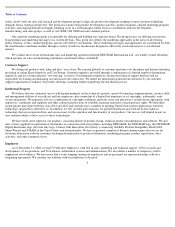Netgear 2008 Annual Report Download - page 21
Download and view the complete annual report
Please find page 21 of the 2008 Netgear annual report below. You can navigate through the pages in the report by either clicking on the pages listed below, or by using the keyword search tool below to find specific information within the annual report.
Table of Contents
As part of undertaking an acquisition, we may also significantly revise our capital structure or operational budget, such as issuing common
stock that would dilute the ownership percentage of our stockholders, assuming liabilities or debt, utilizing a substantial portion of our cash
resources to pay for the acquisition or significantly increasing operating expenses. Our acquisitions have resulted and may in the future result in
charges being taken in an individual quarter as well as future periods, which results in variability in our quarterly earnings. In addition, our
effective tax rate in any particular quarter may also be impacted by acquisitions.
We cannot assure you that we will be successful in selecting, executing and integrating acquisitions. Failure to manage and successfully
integrate acquisitions could materially harm our business and operating results. In addition, if stock market analysts or our stockholders do not
support or believe in the value of the acquisitions that we choose to undertake, our stock price may decline.
We have recently upgraded our financial, demand planning and operational management systems. If we experience problems with the
initial deployment and operation of these new systems, our business and operations will be adversely affected.
We have recently upgraded our financial and enterprise resource planning systems. We have invested, and will continue to invest,
significant capital and human resources in their design and enhancement, which may be disruptive to our underlying business. We depend on
these systems in order to timely and accurately process and report key components of our results of operations, financial position and cash flows.
If the systems fail to operate appropriately or we experience any disruptions or delays in enhancing their functionality to meet current business
requirements, our ability to fulfill customer orders, bill and track our customers, fulfill contractual obligations, accurately report our financials
and otherwise run our business could be adversely affected. Even if we do not encounter these adverse effects, the integration of the new systems
may be much more costly than we anticipated. If we are unable to successfully integrate the new information technology systems as planned, our
financial position, results of operations and cash flows could be negatively impacted.
If disruptions in our transportation network occur or our shipping costs substantially increase, we may be unable to sell or timely
deliver our products and our operating expenses could increase.
We are highly dependent upon the transportation systems we use to ship our products, including surface and air freight. Our attempts to
closely match our inventory levels to our product demand intensify the need for our transportation systems to function effectively and without
delay. On a quarterly basis, our shipping volume also tends to steadily increase as the quarter progresses, which means that any disruption in our
transportation network in the latter half of a quarter will have a more material effect on our business than at the beginning of a quarter.
The transportation network is subject to disruption or congestion from a variety of causes, including labor disputes or port strikes, acts of
war or terrorism, natural disasters and congestion resulting from higher shipping volumes. Labor disputes among freight carriers and at ports of
entry are common, especially in Europe, and we expect labor unrest and its effects on shipping our products to be a continuing challenge for us.
The labor unions for the ports in the west coast of the U.S. are now engaging in contract negotiation with the port operators. If the negotiation
falters and results in strikes, it will severely impact our business. Since September 11, 2001, the rate of inspection of international freight by
governmental entities has substantially increased, and has become increasingly unpredictable. If our delivery times increase unexpectedly for
these or any other reasons, our ability
19
•
entering into territories or markets that we have limited or no prior experience with;
•
establishing or maintaining business relationships with customers, vendors and suppliers who may be new to us;
•
overcoming the employee, customer, vendor and supplier turnover that may occur as a result of the acquisition; and
•
diverting management
’
s attention from running the day to day operations of our business.
























